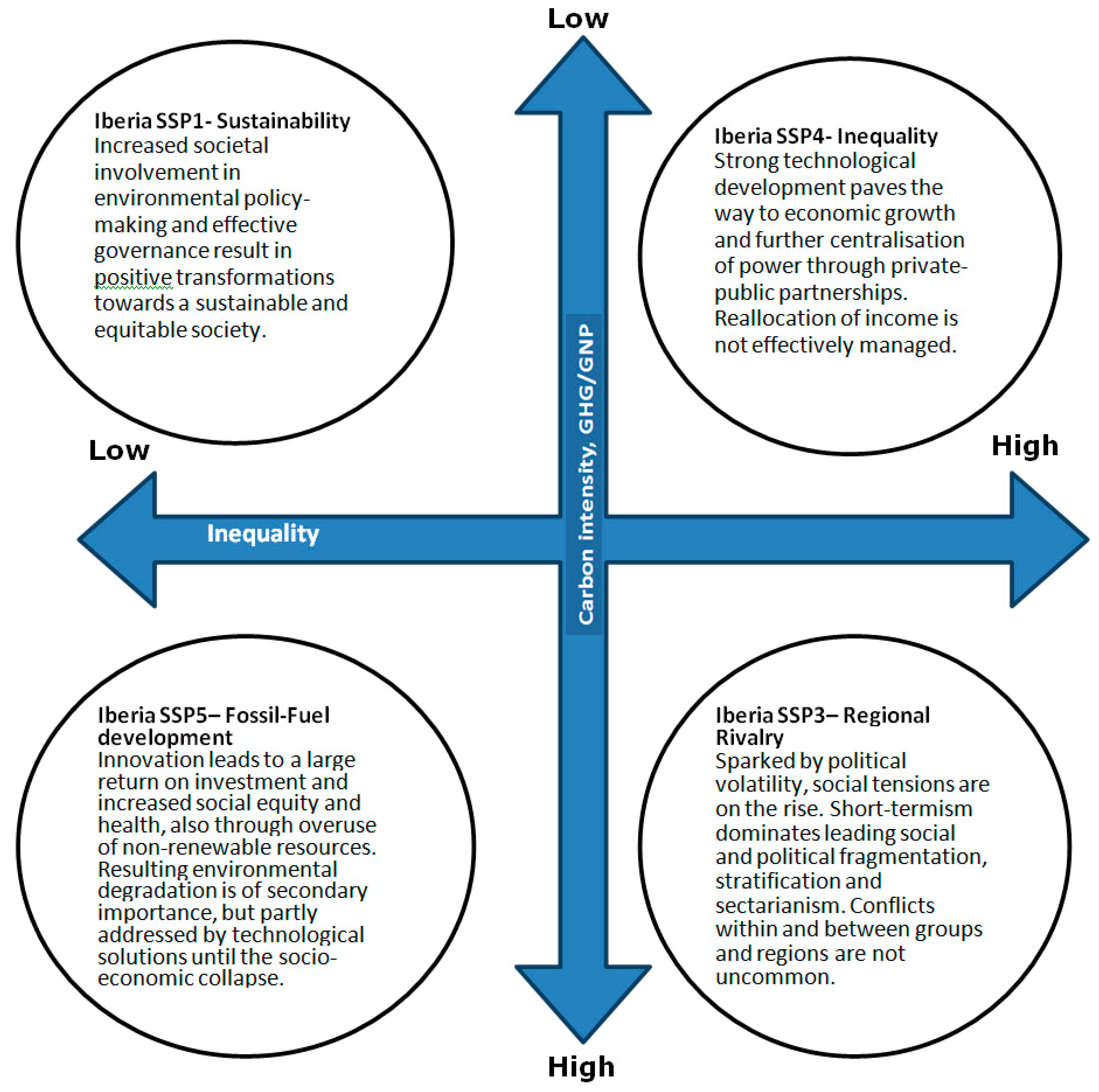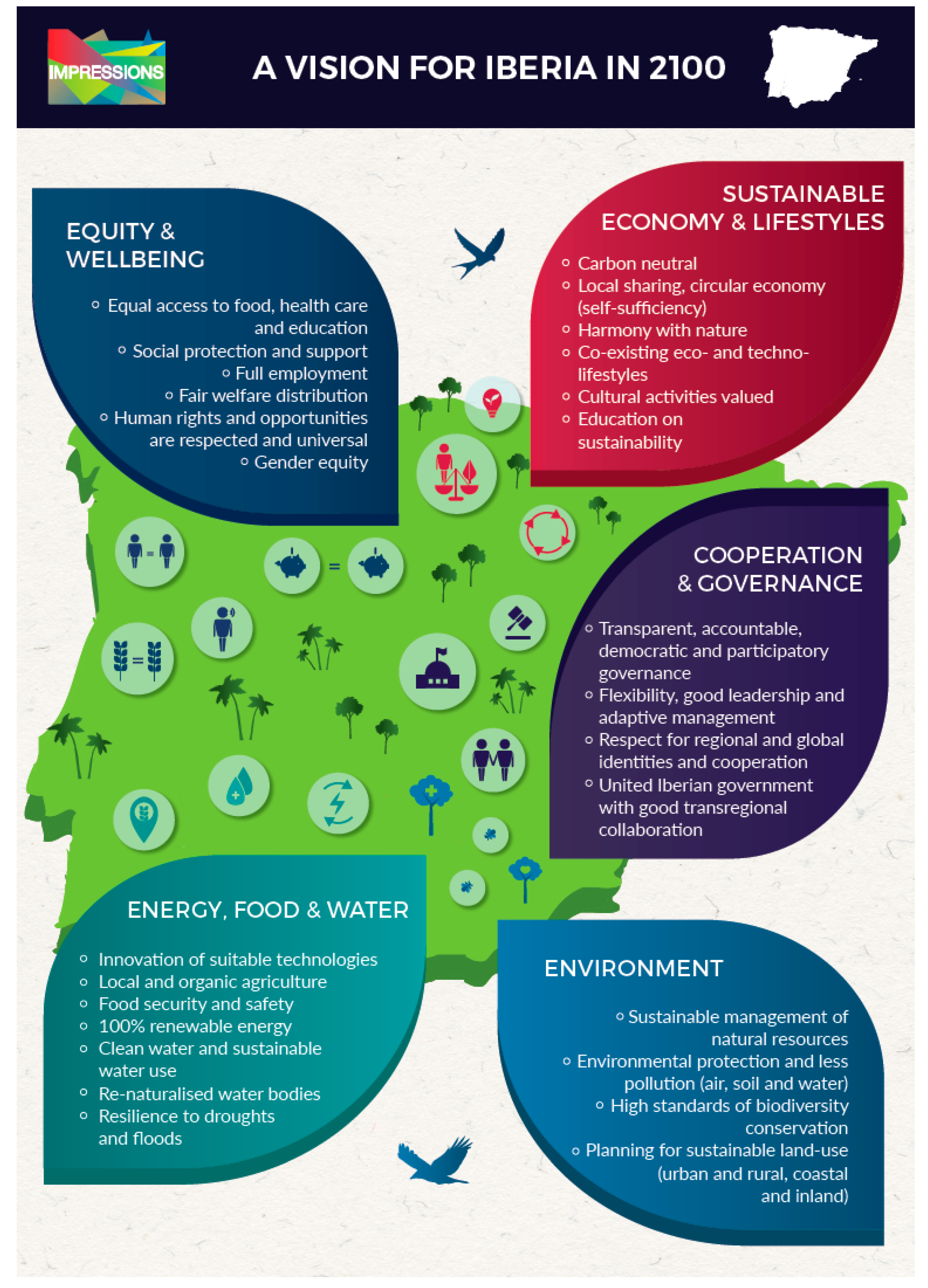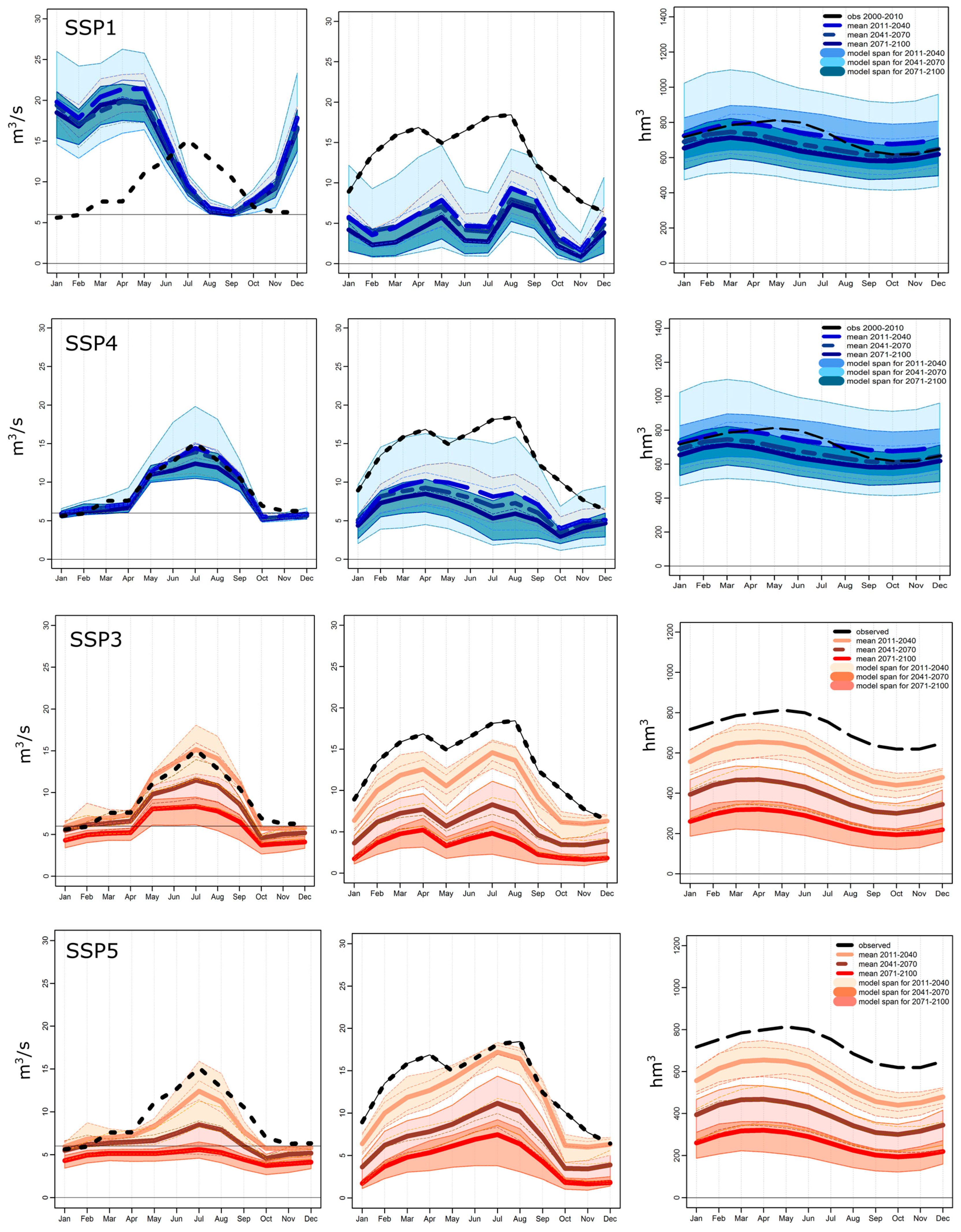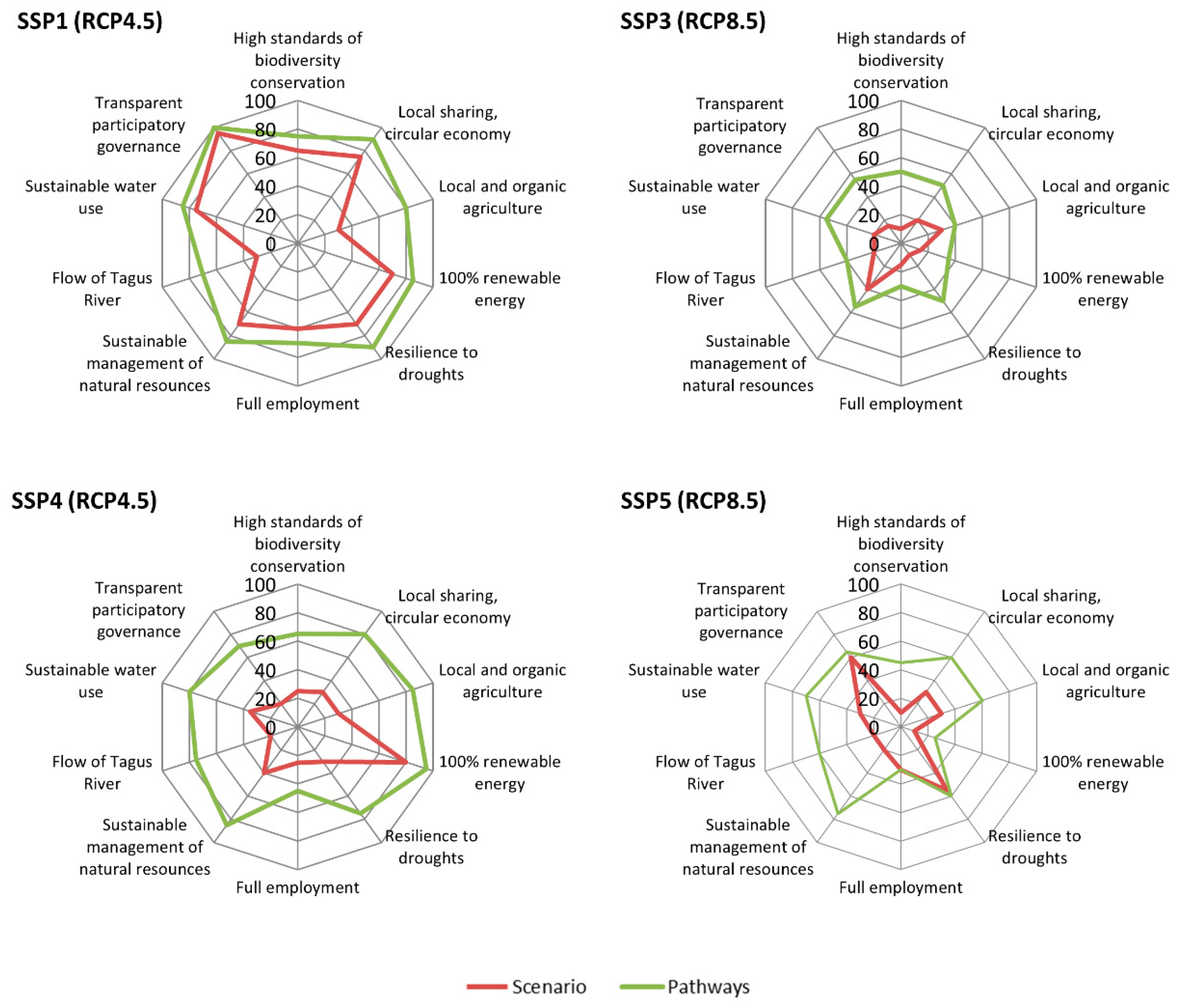Exploring Institutional Transformations to Address High-End Climate Change in Iberia
Abstract
:1. Introduction
2. High-End Climate Change in Iberia
2.1. Social-Ecological and Political Context
2.2. Research Process
2.3. Institutional Knowledge Needs to Confront HECC
2.4. The HECC Participatory Integrated Assessment Process
2.4.1. General Design
2.4.2. Socio-Economic and Climate Scenarios
Iberia SSP1—Sustainability
Iberia SSP3—Regional Rivalry
Iberia SSP4—Inequality
Iberia SSP5—Fossil-Fueled Development
2.4.3. Vision Development
- “Iberia supports greater global co-operation and solidarity, with respect for human rights and distinct identities of people” (Co-operation and identity).
- “Iberia is a coherent, diverse and peaceful territory co-ordinated by transparent Iberian governmental institutions and a highly politically-engaged society” (Governance).
- “All people in Iberia have access to public services and social support, engage in sustainable, community-based lifestyles aligned to context-specific needs and opportunities” (Health, wellbeing and sustainable lifestyles).
- “Sustainable natural resource management and resource protection is ensured through strict policies” (Protecting the environment).
- “Cities are smaller, self-sufficient in terms of energy production, provide space for social activities, and promote sustainability throughout their respective hinterlands” (Sustainable urban planning and land use).
- “The use of Iberian natural resources yields minimum impact on natural ecosystems and is balanced with the maximum reuse, recycling and recirculation of materials” (A sustainable and local economy).
- “Sustainable food and water management and 100% renewable energy production go hand-in-hand with more conscious consumption and access to quality food and water” (Food, water and energy).
- “There is a guaranteed access to education that supports professional, social and practical skills and technological innovation, as well as full employment and fair income distribution” (Income, education and jobs).
- “Adaptation plans and quick response strategies have been deployed to cope with climate change and extreme events” (Resilience).
2.4.4. Solutions and Pathways
- Promote integrated and collaborative water management and sustainable water use: All scenarios include a pathway to promote integrated and collaborative water management and sustainable water use. This is an adaptation pathway that ensures water quality and water quantity and climate adaptation. The pathway addresses the vision elements on “food, water and energy”, “resilience” and “governance”. It also establishes integrated and holistic water management strategies and approaches for Iberia that protects water quality and quantity, adapts to climate change and ensures equal access to water. It also calls for innovative water infrastructures and technologies to improve efficiency in water use, protect water quality and adapt to climate change and for the setting up participatory, multi-level and transboundary water governance systems to manage and control water use and water quality and quantity. In addition, strong regulations, standards and incentives are to be put in place to promote sustainable water use, water efficiency innovation and water monitoring systems in line with ecological flows.
- Promote shifts to sustainable lifestyles: All scenarios include a pathway to promote a shift towards sustainable lifestyles, which involves the transition to sustainable production and consumption patterns and behaviors, and major changes to the education system. This is a transformation pathway that involves fundamental shifts in values, behaviors and practices. The pathway addresses vision elements on “health, well-being and sustainable lifestyles” and “income, education and jobs”. It also sets up a new education system to which everyone has access and that integrates education about sustainability, solidarity, traditional knowledge, skills and entrepreneurship. Education is provided and targeted for all age groups and to intergenerational groups for solidarity; environmental and social education is integrated in schools; there is significant investment in environmental and social research and includes awareness-raising activities to promote awareness on self-sufficient lifestyles, energy efficiency, food waste reduction, intermodal mobility, climate change, water savings and reuse, and different diets. The SSP3 and SSP4 pathways facilitate social cohesion and protect social and human rights, while the SSP1 and SSP5 pathways create alternative community-based markets. New markets are set up at the local level with job sharing. Alternative trading systems are put in place such as local currencies and time banks. Local renewable energy is promoted for self-sufficiency.
- Promote ecological agriculture: This pathway develops integrated policy frameworks for ecological agriculture that are adapted to ecological and context-specific needs and conditions and to climate change. The pathway shifts towards ecological agricultural practices to adapt agriculture to climate change impacts and land and water availability. Conservation agriculture is implemented. It includes a shift towards agro-forestry and sustainable forestry and supports technological innovation to facilitate ecological agriculture and protect water quality and quantity. This pathway puts in place regulations, standards and incentives to promote ecological agriculture and the shift towards integrated land use management and the training of farmers in ecological agricultural practices, which in turn also contributes to rural development and social cohesion.
- Promote democratic and multi-level governance for sustainability and social equity: SSP1, SSP4 and SSP5 include a pathway to promote policy and governance for sustainability and social equity. This is a transformation pathway that involves fundamental shifts in the ways the governance system is set up to enable multi-level cooperation, transparency and participation in line with long-term and integrated sustainability and resilience goals. The pathway addresses vision elements on “governance” and “co-operation and identity”. Iberia develops integrated environmental protection frameworks and policies that integrate nature into market and planning activities and fit policies to specific regional conditions to harmonize social and economic development in line with environmental conditions and climate change. A democratic, fair and transparent governance system is ensured, public participation is increased and political power is decentralized. NGOs are encouraged to take an active role in decision-making and engaging people. The pathway sets up collaborative and multi-level governance across scales and sectors. Participation forums are established all the way from schools to parliaments. Social networks and enterprises and political activism are fostered to ensure broad participation and social collaboration. The SSP5 pathway puts in place monitoring systems to ensure that decision-making is supported by science and to measure individual consumption in agriculture.
- Promote shifts to low-carbon and local energy systems and markets: SSP1, SSP3 and SSP4 include a pathway to promote shifts to low-carbon and local energy systems and markets to support urban and rural development. This is a mitigation pathway that includes technological innovation for renewable energy production on local and regional levels and for energy and resource efficiency. The pathway addresses vision elements on “food, water and energy” and “sustainable and local economy”. The pathway invests in a diversified local economy that is adapted to context conditions, promotes production and consumption based on local resources and creates local jobs. Local markets are created based on local resources for production, waste, water, energy and services. It develops green technological innovations to increase energy efficiency and achieve self-sufficient renewable energy production. The implementation of renewable energies and decreasing energy consumption is incentivized and enforced through subsidies and regulations. Iberia divests from fossil and nuclear energy and the implementation of green energy is made compulsory. An annual carbon budget is established and carbon taxes based on real carbon costs are introduced. For example, a carbon tax on tourism is established.
2.4.5. Modeling Results
- There are projected decreases in the overall water availability in the Tagus river basin, under all scenarios, by 2071–2100 (Figure 4): The modeling results for Iberia project significant changes in annual and seasonal precipitation, with uncertainties on both the strength of the change and its seasonal variations. From these results it is evident that the Iberian Peninsula and the Tagus River basin area in particular will continue on their current trend towards a drier and more vulnerable landscape. Seasonal variability is expected to play a major role in the socio-economic outcomes under HECC scenarios, since current water resources and agroforestry management in that area are highly dependent on accumulated precipitation during the hydrological year (October to September), in particular during the wet period (October to April).
- The operation of the water management infrastructure (based on the example of the headwaters of the Tagus river catchment) will be strongly affected by the decreasing water availability under both RCP4.5 and RCP8.5, but results are dependent on the socio-economic narrative that is followed (Figure 5): When following the SSP1 × RCP4.5 narrative it is possible to impose and sustain the environmental flows in the river and increase the adaptive capacity of the two reservoirs in the headwaters of the river Buendía and Entrepeñas. However, in this case the water supply for the economic needs (to Segura River Basin, via Tagus Segura Water Transfer) has to be substantially decreased. Under the SSP3 x RCP8.5 scenario, even in the case of complete negligence towards the environmental state of the river (imposing constant minimum water flow), the economic needs aspired cannot be reached, due to dramatic decrease in the water availability. This situation also leads to significant decrease of the water volumes, stored in the reservoirs due to combination of water management strategies and effects of climate change.
2.4.6. Potential of Pathways to Achieve the Vision
3. Discussion: The Role of Cross-Border Co-Operation
4. Conclusions: Integrated Climate Governance under High-End Climate Change in Iberia
Acknowledgments
Author Contributions
Conflicts of Interest
References
- High-End Climate Change in Europe. 2017. Available online: www.impressions-project.eu (accessed on 8 January 2018).
- Miller, T.R.; Wiek, A.; Sarewitz, D.; Robinson, J.; Olsson, L.; Kriebel, D.; Loorbach, D. The future of sustainability science: A solutions-oriented research agenda. Sustain. Sci. 2013, 9, 238–246. [Google Scholar] [CrossRef]
- Nalau, J.; Handmer, J. When is transformation a viable policy alternative? Environ. Sci. Policy 2015, 54, 349–356. [Google Scholar] [CrossRef]
- Patterson, J.; Schulz, K.; Vervoort, J.; van der Hel, S.; Widergerg, O.; Adler, C.; Hurlbert, M.; Anderton, K.; Sethi, M. Exploring the governance and politics of transformations towards sustainability. Environ. Innov. Soc. Transit. 2017, 24, 1–16. [Google Scholar] [CrossRef]
- Berman, J.R.; Quinn, H.C.; Paavola, J. The role of institutions in the transformation of coping capacity to sustainable adaptive capacity. Environ. Dev. 2012, 2, 86–100. [Google Scholar] [CrossRef]
- Tàbara, J.D.; St. Clair, A.L.; Hermansen, E.A.T. Transforming communication and knowledge production processes to address high-end climate change. Environ. Sci. Policy 2017, 70, 31–37. [Google Scholar] [CrossRef]
- O’Neill, B.C.; Kriegler, E.; Riahi, K.; Ebi, K.; Hallegatte, S.; Carter, T.R.; Mathur, R.; van Vuuren, D. A new scenario framework for climate change research: The concept of shared socioeconomic pathways. Clim. Chang. 2014, 122, 387–400. [Google Scholar] [CrossRef]
- Tàbara, J.D.; Roca, E.; Madrid, C.; Valkering, P.; Wallman, P.; Weaver, P. Participatory Integrated Sustainability Assessment of Water Systems. Lessons from the Ebro River Basin. Int. J. Innov. Sustain. Dev. 2008, 3, 48–69. [Google Scholar] [CrossRef]
- Weaver, P.M.; Haxeltine, A.; Van De Kerkhof, M.; Tàbara, J.D. Mainstreaming action on climate change through participatory appraisal. Int. J. Innov. Sustain. Dev. 2006, 1, 238–259. [Google Scholar] [CrossRef]
- Tàbara, J.D. Integrated Climate Governance and Sustainable Development. In European Research on Sustainable Development. Vol I: Transformative Science Approaches for Sustainable Development; Jaeger, C.C., Tàbara, J.D., Jaeger, J., Eds.; Springer and European Commission: Heidelberg, Germany, 2011; pp. 91–109. [Google Scholar]
- Tàbara, J.D.; Ilhan, A. Culture as trigger for sustainability transition in the water domain: The case of the Spanish water policy and the Ebro river basin. Reg. Environ. Chang. 2008, 8, 59–71. [Google Scholar] [CrossRef]
- Neto, S. Drivers for change in Water Policy: The Guadiana HELP Basin experience. J. Hydrol. Environ. 2011, 17, 11. [Google Scholar]
- Cosens, B.; Gunderson, L.; Allen, C.; Harm Benson, M. Identifying Legal, Ecological and Governance Obstacles, and Opportunities for Adapting to Climate Change. Sustainability 2014, 6, 2338–2356. [Google Scholar] [CrossRef]
- Cots, F.; Tàbara, J.D.; McEvoy, D.; Werners, S.; Roca, E. Cross-border organisations as an adaptive water management response to climate change: The case of the Guadiana river basin. Environ. Plan. C Politic Space 2009, 27, 876–893. [Google Scholar] [CrossRef]
- Capela Lourenço, T.; João Cruz, M.; Carlsen, H.; Dzebo, A.; Tàbara, J.D.; Cots, F.; Haslett, J.; Harrison, P. Common Frame of Reference to Support the Understanding of Adaptation Decision-Making under High-End Scenarios. 2015. IMPRESSIONS Project Deliverable D1.1. Available online: http://www.impressions-project.eu/documents (accessed on 8 January 2018).
- Dzebo, A.; João Cruz, M.; Capela Lourenço, T.; Carlsen, H.; Dunn, M.; Cots, F.; Tàbara, J.D.; Juhász-Horváth, L.; Pintér, L. Assessment of Decision-Makers’ Needs and Capacities, Drivers and Barriers for Using Scenarios, Modelling and Pathways Analysis Impressions Project Deliverable D1.2. 2015. Available online: http://www.impressions-project.eu/documents (accessed on 8 January 2018).
- Gramberger, M.; Zellmer, K.; Kok, K.; Metzger, M. Stakeholder integrated research (STIR): A new approach tested in climate change adaptation research. Clim. Chang. 2015, 128, 201–214. [Google Scholar] [CrossRef]
- Hegger, D.; Lamers, M.; Van Zeijl-Rozema, A.; Dieperink, C. Conceptualising joint knowledge production in regional climate change adaptation projects: Success conditions and levers for action. Environ. Sci. Policy 2012, 18, 52–65. [Google Scholar] [CrossRef]
- Kok, K.; Pedde, S. IMPRESSIONS Socio-Economic Scenarios. IMPRESSIONS Project Deliverable 2.2. Available online: http://www.impressions-project.eu/documents/1/ (accessed on 8 January 2018).
- Miller, C.A.; O’Leary, J.; Graffy, E.; Stechel, E.B.; Dirks, G. Narrative futures and the governance of energy transitions. Futures 2015, 70, 65–74. [Google Scholar] [CrossRef]
- Jordan, A.; Rayner, T.; Schroeder, H.; Adger, N.; Anderson, K.; Bows, A.; Le Quéré, C.; Joshi, M.; Mander, S.; Vaughan, N.; et al. Going beyond two degrees? The risks and opportunities of alternative options. Clim. Policy 2013, 13, 751–769. [Google Scholar] [CrossRef] [Green Version]
- Van Vuuren, D.P.; Edmonds, J.; Kainuma, M.; Riahi, K.; Thomson, A.; Hibbard, K.; Hurtt, G.C.; Kram, T.; Krey, V.; Lamarque, J.F. The representative concentration pathways: An overview. Clim. Chang. 2011, 109, 5–31. [Google Scholar] [CrossRef]
- Van Vuuren, D.; Kriegler, E.; O’Neill, B.C.; Ebi, K.L.; Riahi, K.; Carter, T.R.; Edmonds, J.; Hallegatte, S.; Kram, T.; Mathur, R.; et al. A new scenario framework for Climate Change Research: Scenario matrix architecture. Clim. Chang. 2014, 122, 373–386. [Google Scholar] [CrossRef]
- Kok, K.; Pedde, S.; Gramberger, M.; Harrison, P.; Holman, I. New European socio-economic scenarios for climate change research: Operationalising concepts to extend the Shared Socioeconomic Pathways. Reg. Environ. Chang. 2017. submitted. [Google Scholar]
- Wiek, A.; Iwaniec, D. Quality criteria for visions and visioning in sustainability science. Sustain. Sci. 2014, 9, 497–512. [Google Scholar] [CrossRef]
- Bielsa, J.; Cazcarro, I. Implementing Integrated Water Resources Management in the Ebro River Basin: From Theory to Facts. Sustainability 2015, 7, 441–464. [Google Scholar] [CrossRef]
- Pahl-Wostl, C.; Conca, K.; Kramer, A.; Maestu, J.; Schmidt, F. Missing links in global water governance: A processes-oriented analysis. Ecol. Soc. 2013, 18, 33. [Google Scholar] [CrossRef]
- Olsson, P.; Gunderson, L.; Carpenter, S.; Ryan, P.; Lebel, L.; Folke, C.; Holling, C.S. Shooting the rapids: Navigating transitions to adaptive governance of social-ecological systems. Ecol. Soc. 2006, 11, 18. [Google Scholar] [CrossRef]
- Lobanova, A.; Liersch, S.; Tàbara, J.D.; Koch, H.; Hattermann, F.F.; Krysanova, V. Harmonizing human-hydrological systems under climate change: The case of the headwaters of the Tagus River. J. Hydrol. 2017, 548, 436–447. [Google Scholar] [CrossRef]
- Folke, C.; Carpenter, S.R.; Walker, B.; Scheffer, M.; Chapin, T.; Rockström, J. Resilience thinking: Integrating resilience, adaptability and transformability. Ecol. Soc. 2010, 15, 20. [Google Scholar] [CrossRef]
- Westley, F.R.; Tjornbo, O.; Schultz, L.; Olsson, P.; Folke, C.; Crona, B.; Bodin, Ö. A theory of transformative agency in linked social-ecological systems. Ecol. Soc. 2013, 18, 27. [Google Scholar] [CrossRef]
- Fleming, A. Informing adaptation responses to climate change through theories of transformation. Glob. Environ. Chang. 2012, 22, 115–126. [Google Scholar]
- Michaels, S.; Goucher, N.P.; McCarthy, D. Policy Windows, Policy Change, and Organizational Learning: Watersheds in the Evolution of Watershed Management. Environ. Manag. 2006, 38, 983–992. [Google Scholar] [CrossRef] [PubMed]
- Gillard, R.; Gouldson, A.; Paavola, J.; Van Alstine, J. Transformational responses to climate change: Beyond a systems perspective of social change in mitigation and adaptation. Wiley Interdiscipl. Rev. Clim. Chang. 2016, 251–265. [Google Scholar] [CrossRef]
- Lafferty, W.; Hovden, E. Environmental policy integration: Towards an analytical framework. Environ. Polit. 2003, 12, 1–22. [Google Scholar] [CrossRef]
- Mickwitz, P.; Aix, F.; Beck, S.; Carss, D.; Ferrand, N.; Görg, C.; Jensen, A.; Kivimaa, P.; Kuhlicke, C.; Kuindersma, W.; et al. Climate Policy Integration, Coherence and Governance; Partnership for European Environmental Research (PEER): Leipzig, Germany, 2009. [Google Scholar]
- Nunan, F.; Campbell, A.; Foster, E. Environmental Mainstreaming: The Organisational Challenges of Policy Integration. Public Adm. Dev. 2012, 32, 262–277. [Google Scholar] [CrossRef]
- Tompkins, E.; Adger, W.N. Does adaptive management of natural resources enhance resilience to climate change? Ecol. Soc. 2004, 9. [Google Scholar] [CrossRef]
- Urwin, K.; Jordan, A. Does public policy support or undermine climate change adaptation? Exploring policy interplay across different scales of governance. Glob. Environ. Chang. 2008, 18, 180–191. [Google Scholar] [CrossRef]
- Brown, K.; O’Neill, S.; Fabricius, C. Social Science Understandings of Transformation. In The Complexity and Urgency of Global Environmental Change and Social Transformation, World Social Science Report 2013: Changing Global Environments; UNESCO Publishing: Paris, France, 2013; pp. 100–107. [Google Scholar]
- Crona, B.; Bodin, O. Power Asymmetries in Small-Scale Fisheries: A Barrier to Governance Transformability? Ecol. Soc. 2010, 15, 32. [Google Scholar] [CrossRef]
- Ernstson, H. Transformative Collective Action: A Network Approach to Transformative Change in Ecosystem-Based Management. In Social Networks and Natural Resource Management: Uncovering the Social Fabric in Environmental Governance; Cambridge University Press: Cambridge, UK, 2011; pp. 1–24. [Google Scholar]
- O’Brian, K. Global environmental change II: From adaptation to deliberate transformation. Prog. Hum. Geogr. 2012, 36, 667–676. [Google Scholar] [CrossRef]
- Walker, B.; Holling, C.S.; Carpenter, S.R.; Kinzig, A. Resilience, adaptability and transformability in social-ecological systems. Ecol. Soc. 2004, 9, 5. [Google Scholar] [CrossRef]
- Pahl-Wostl, C.; Becker, G.; Knieper, C.; Sendzimir, J. How multilevel societal learning processes facilitate transformative change: A comparative case study analysis on flood management. Ecol. Soc. 2013, 18, 58. [Google Scholar] [CrossRef]
- Blatter, J. Beyond hierarchies and networks: Institutional logics and change in transboundary spaces. Governance 2003, 16, 503–526. [Google Scholar] [CrossRef]
- Marshall, N.A.; Park, E.S.; Adger, N.W.; Brown, K.; Howden, M.S. Transformational capacity and the influence of place and identity. Environ. Res. Lett. 2012, 7, 034022. [Google Scholar] [CrossRef]
- Van Kerkhoff, L.E.; Lebel, L. Coproductive capacities: Rethinking science-governance relations in a diverse world. Ecol. Soc. 2015, 20, 1–14. [Google Scholar] [CrossRef]
- Wolfram, M. Conceptualizing urban transformative capacity: A framework for research and policy. Cities 2016, 51, 121–130. [Google Scholar] [CrossRef]
- Woodward, J. Overcoming systemic roadblocks to sustainability: The evolutionary redesign of worldviews, institutions, and technologies. Proc. Natl. Acad. Sci. USA 2009, 106, 2483–2489. [Google Scholar]
- Ziervogel, G.; Cowen, A.; Ziniades, J. Moving from Adaptive to Transformative Capacity: Building Foundations for Inclusive, Thriving, and Regenerative Urban Settlements. Sustainability 2016, 8, 955. [Google Scholar] [CrossRef]
- Feola, G. Societal transformation in response to global environmental change: A review of emerging concepts. Ambio 2015, 44, 376–390. [Google Scholar] [CrossRef] [PubMed]
- McEvoy, D.; Cots, F.; Longdale, K.; Tàbara, J.D. The role of institutional capacity in enabling climate change adaptation. The case of the Guadiana river basin. In Transborder Environmental and Natural Resource Management, Proceedings of the International Symposium in Transborder Environmental and Natural Resource Management, Kyoto, Japan, 5–7 December 2007; De Jong, W., Snelder, D., Ishikawa, N., Eds.; Centre of Integrated Area Studies: Kyoto, Japan, 2010; pp. 49–60. [Google Scholar]
- Huitema, D.; Meijerink, S. Realizing water transitions: The role of policy entrepreneurs in water policy change. Ecol. Soc. 2010, 15, 26. [Google Scholar] [CrossRef]
- Huitema, D.; Mostert, E.; Egas, W.; Moellenkamp, S.; Pahl-Wostl, C.; Yalcin, R. Adaptive water governance: Assessing the institutional prescriptions of adaptive (co-)management from a governance perspective and defining a research agenda. Ecol. Soc. 2009, 14, 26. [Google Scholar] [CrossRef]
- Perkmann, M. Policy entrepreneurship and multilevel governance: A comparative study of European cross-border regions. Environ. Plan. C Politic Space 2007, 25, 861–879. [Google Scholar] [CrossRef]
- Sherer, R.; Zumbush, K. Limits for successful cross-border governance of environmental (and spatial) development: The Lake Constance Region. Procedia Soc. Behav. Sci. 2011, 14, 101–120. [Google Scholar] [CrossRef]






| Pathway | SSP1 | SSP3 | SSP4 | SSP5 |
|---|---|---|---|---|
| Promote integrated and collaborative water management and sustainable water use | √ | √ | √ | √ |
| Promote shifts to sustainable lifestyles | √ | √ | √ | √ |
| Promote ecological agriculture | √ | √ | √ | √ |
| Promote democratic and multi-level governance for sustainability and social equity | √ | √ | √ | |
| Promote shifts towards low-carbon and local energy systems and markets | √ | √ | √ |
| SSP1 | SSP3 | SSP4 | SSP5 |
|---|---|---|---|
|
|
|
|
© 2018 by the authors. Licensee MDPI, Basel, Switzerland. This article is an open access article distributed under the terms and conditions of the Creative Commons Attribution (CC BY) license (http://creativecommons.org/licenses/by/4.0/).
Share and Cite
Tàbara, J.D.; Cots, F.; Pedde, S.; Hölscher, K.; Kok, K.; Lovanova, A.; Capela Lourenço, T.; Frantzeskaki, N.; Etherington, J. Exploring Institutional Transformations to Address High-End Climate Change in Iberia. Sustainability 2018, 10, 161. https://doi.org/10.3390/su10010161
Tàbara JD, Cots F, Pedde S, Hölscher K, Kok K, Lovanova A, Capela Lourenço T, Frantzeskaki N, Etherington J. Exploring Institutional Transformations to Address High-End Climate Change in Iberia. Sustainability. 2018; 10(1):161. https://doi.org/10.3390/su10010161
Chicago/Turabian StyleTàbara, Joan David, Francesc Cots, Simona Pedde, Katharina Hölscher, Kasper Kok, Anastasia Lovanova, Tiago Capela Lourenço, Niki Frantzeskaki, and John Etherington. 2018. "Exploring Institutional Transformations to Address High-End Climate Change in Iberia" Sustainability 10, no. 1: 161. https://doi.org/10.3390/su10010161





